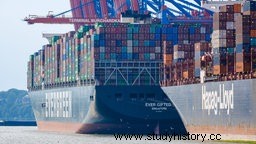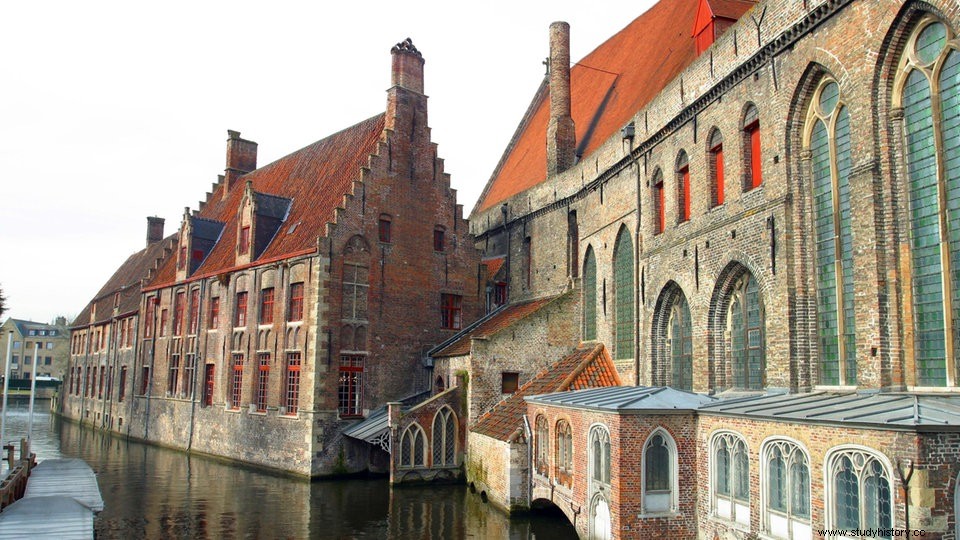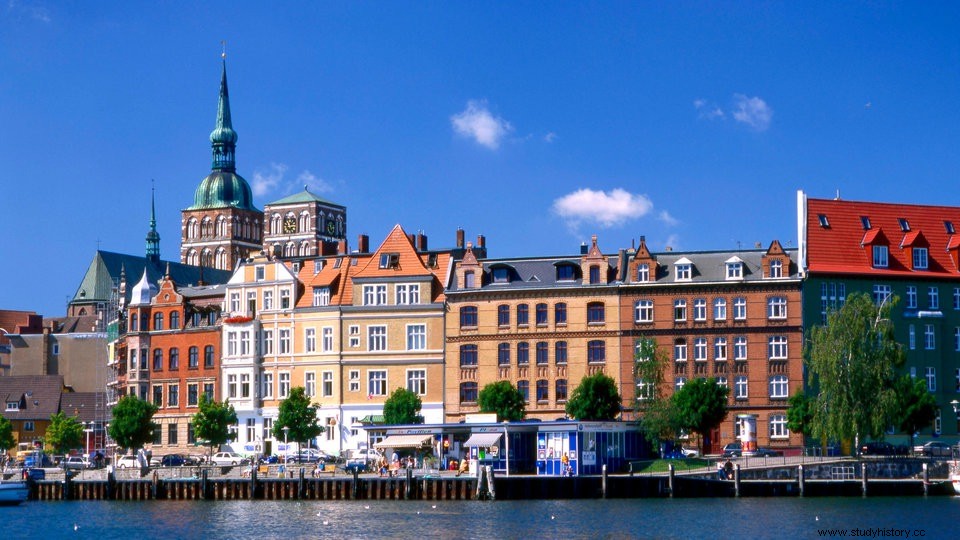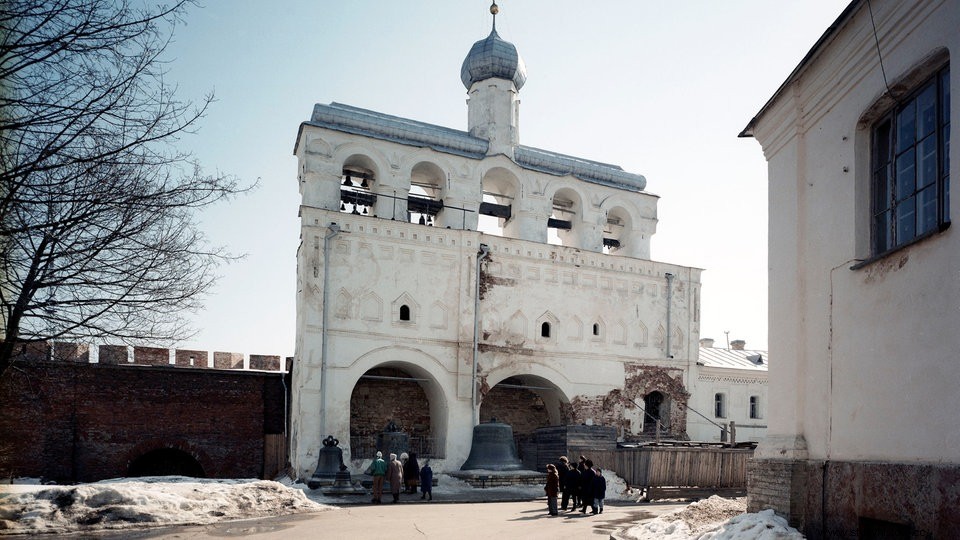In the middle of the 12th century, German merchants formed cooperatives. They thus laid the foundation for the Hanseatic League, which asserted their commercial interests across city and state borders.
German merchants on Gotland
The Hanseatic League (Old High German for "group" or "entourage") was an interest group for seafaring merchants who, together in search of good business, sent their valuable cargo on great, adventurous journeys.
As early as the 11th century, a group of Cologne merchants had bought their own house in London in order to buy the excellent English sheep's wool cheaply and in large quantities in England, which they sold dearly at home.
The German traders were very welcome to the English kings, as they lent them large sums of money. In return, the German merchants were under the protection of the English crown. "Stalhof" was the name of this German trading post in England, here the goods were "gestalt", that is, checked and marked with a lead seal.
The idea behind the alliance of German merchants was the realization that good money could only be earned through direct trade without intermediaries. In the late Middle Ages, German merchants traded goods from northern Europe for products from the south in the coastal areas of northern and eastern Europe.
-
 History of World Trade | more
History of World Trade | more
The men they traded with came from the island of Gotland, east of mainland Sweden. The Gotlanders were large farmers who made good money as middlemen. They offered goods for sale that they obtained from Russia, Sweden, Norway and Denmark. But soon the exchange of goods via the Gotlanders was no longer enough for the German traders.
When North German princes and the city of Lübeck ended Danish supremacy in the Baltic Sea in a short war in the 13th century, German merchants gained access to the coveted Baltic Sea trade for the first time. They began using Gotland as a way station to engage in direct long-distance trade with Russia and Scandinavia. So they became competitors of the Gotlanders and soon put them out of business.
Foundation of the Hanseatic offices
In 1235, German merchants opened a trading post in Bruges, Flanders, then a center of European trade. Over time, the traveling merchants from Germany founded local branches in more and more cities, the so-called Hanseatic offices. Famous offices were London and Bruges, Bergen in Norway and Novgorod in the far north of Russia.

Bruges was one of the most important trading cities in the Middle Ages
These trading bases offered German long-distance traders (similar to today's embassies) safe quarters on foreign soil. The large trading posts networked the cities connected to them, which quickly benefited from the trading members of the Hanseatic League. This is how the 200-year-old Hanseatic League of merchants in the 12th century culminated in the Hanseatic League of Cities.
Association of Cities
By the 14th century an economic area had developed, stretching from Novgorod and Reval (now Tallinn) in the east to Bruges and London in the west.
The members of the Hanseatic League had become a decisive power factor. Due to their enormous economic power, they had gained great political influence. The economic success had made many merchant families extremely rich. This increased the self-confidence of the trading citizens compared to the nobility.

Tallinn was an important base on the Baltic Sea
The young, fast-growing cities in the German Empire gained self-confidence through their successful citizens. They began to coordinate their interests and, working together, wrested privileges and rights from the local rulers. Or they bought special permits and privileges directly from the German Emperor for large sums of money.
As a result, they became "imperial"; they were legally subordinate to the emperor alone. Claims on the part of the territorial princes – the German Empire was then a patchwork quilt of different principalities and duchies – were thus invalidated. In this way, the rich cities were able to avoid additional duties and taxes to be paid.
Lübeck and Hamburg are the first
To this day, the special political status of the city-states of Hamburg and Bremen is a result of the time when they were free and directly dependent on the Reich. However, the richest Hanseatic city was Lübeck, which soon became the head of the Hanseatic League. The first cities to form an alliance were Lübeck and Hamburg. Others soon followed.
In addition to coastal cities such as Lübeck, Hamburg, Bremen, Wismar, Rostock, Stralsund, Greifswald, Danzig and Königsberg, the Hanseatic League also included inland cities such as Cologne, Dortmund, Hanover, Naumburg and Berlin.

Stralsund was a member of the Hanseatic League from a very early stage
There has never been a real definition of the Hanseatic League. At the heyday of the Hanseatic League from the 14th to the 16th century there were up to 200 cities in the Hanseatic League. Accession was subject to purely economic interests. If a city promised itself a financial advantage, it joined the federal government.
"Hanse" (also "hense" or "henze") was also the name of the fee that merchants and cities had to pay when they joined. Because the representation of interests costs money:trading privileges often had to be bought at a high price, officials bribed and wars financed when hostile powers opposed the Hanseatic cities.
Hanse Days
When the cities began to coordinate their interests in order to be able to perceive them better, they created a body in which they appeared together - the Hanseatic Day. In 1356 the first Hanseatic Days took place in Lübeck. At these meetings, which lasted until 1669, the envoys of the Hanseatic cities came together, discussed commercial contracts, the admission or exclusion of members and how to deal with trading privileges.
The Hanseatic Day was a very loose structure, even a curiosity from a legal point of view. Because according to the legal situation, the alliance of cities did not exist at all. Although the Hansetag was de facto the general decision-making body of the Hanseatic cities, there was no budget, no statute, no association and no written contract.
Nevertheless, the concentrated economic power of the medieval German Empire concentrated on these Hanseatic days and made decisions that had a direct impact on people's everyday lives.
Decline of the Hanseatic League
The decline of the Hanseatic League began in the mid-15th century. The rulers of the neighboring countries of Denmark, the Netherlands and Russia gained political power and threatened the Hanseatic cities' monopoly on trade and fishing. The tax exemptions and privileges of the Hanse merchants, which had been maintained for centuries, were restricted.
In 1429 Denmark began to systematically levy a toll on passing merchant ships. In 1494 Tsar Ivan III. the Hanseatic office in Novgorod. In 1603 the Stalhof in London was closed.

In 1494 Tsar Ivan III. the Hanseatic office in Novgorod
The German sovereigns began to assert themselves against the cities and accelerated the decline of the Hanseatic League. They forbade the inner-German Hanseatic cities from forming an alliance with the important coastal cities in the north and forced them to leave the alliance. At the same time, the English and Dutch were increasingly penetrating the economic area of the Baltic Sea. The Hanseatic League faced strong competition.
Hanseatic solidarity soon fell victim to the increasingly complex political and economic circumstances of the 15th century, as it became more difficult to make uniform decisions. The Hanse spoke less and less with one voice.
While international trade opened up new overseas markets towards the end of the 15th century, the Hanseatic League became increasingly rigid in its inflexible adherence to traditional privileges. As a construct of the Middle Ages, the league of merchants and towns was no longer up to the economic and political awakening of Europe into the modern age.
